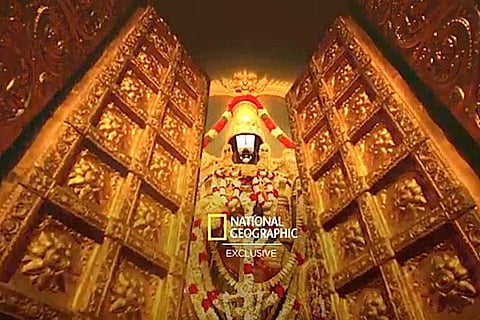

by Venkat Parthasarathy
National Geographic took more than a year to film Inside Tirumala Tirupati in two schedules, the second coinciding with the ‘Brahmotsavam’, a nine-day religious festival.
Firstly, kudos the team for getting access to shoot at the temple. The ground visuals, the trek, the hill-side and the colourful festivities are surely a visual treat in HD. Lot of work seems to have been put into post production – editing, scripting, visual effects and sound design.
While the 45 minute documentary serves the purpose of a tourist travel guide to the 'Biggest piligrim centre' in the World and 'the richest temple on the planet', the sthala puranam (historical tales of the place) misses many aspects of the rich traditions of the holy place.
The documentary has used detailed graphics to explain the temple layout focusing a lot on the crowd management of 60,000-80,000 people on an average day. But the repeated visuals do not do justice to the channel's reputation, and the extensive focus on the kitchens that prepare meals and laddoos for lakhs of pilgrims everyday took up too much time.
The entire programme seemed to be an exercise in showcasing the administration and management of Tirumala Tirupati Devasthanams (TTD) and their operations, the technology used, the processes and a brief look at the annual Brahmotsavams, rather than the divinity surrounding Lord Venkateswara.
One of the important aspects of the sthala puranam of the Kshetra (region) is the legend that Tirumala was originally called “Adivarahakshetra” (dwelling place of Sri Bhu Varaha Swamy).
According to Brahmapurana, it is Lord Sri Bhu Varaha Swamy who granted land to Lord Sri Venkateswara Swamy on his request to reside in the sacred Seven Hills. As a thanksgiving gesture, Lord Sri Venkateswara Swamy had gifted the privilege of first darshan and first naivedyam to Lord Sri Bhu Varaha Swamy. Thus as per the tradition, it is imperative for the pilgrims to pay a visit to Sri Bhu Varaha Swamy before visiting Lord Sri Venkateswara Swamy.
Missing in the narrative are also the legends of the Azhwars and the Acharyas and their pasurams (holy verses) and kainkaryams (services) that make Tirumala what it is today. The legend of the crowbar at the entrance, the story of Ananthazhwar and the camphor on the Lord’s chin would have added value too.
A brief mention of the famed Suprabhatam, the holy verses of awakening the Lord and his consorts and its significance, would have been appreciated.
There was also no reference to Thondaman Chakravarthy, Krishnadeva Raya and others who contributed their might to the construction of this temple.
Though the documentary was on Tirumala and Tirupati, ardent devotees missed a mention of Goddess Padmavathi and the legend of Sri Venkateswara’s marriage and the debt to Kubera that the devotees pay though their offerings to the Hundi.
Given the wonderful portrayal of the Jagannath of Puri in their earlier series, NatGeo could have done a bit more research on the Temple history to produce a more comprehensive narration.
Note: Views expressed are personal opinions of the author.